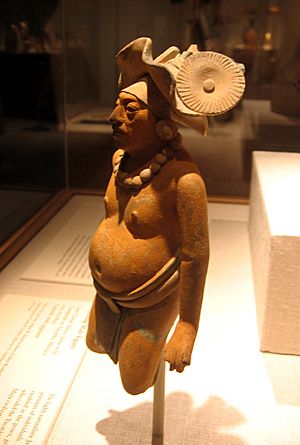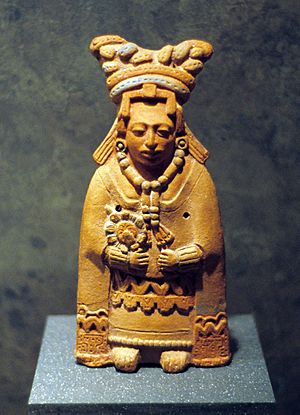Jaina Island facts for kids
Jaina Island is an ancient Maya archaeological site in the Mexican state of Campeche. It is a small island made of limestone, located on the Yucatán Peninsula's Gulf coast. Only a small tidal channel separates it from the mainland.
Jaina Island was a special burial place for important Maya people. It is famous for the many beautiful ceramic figurines found there during excavations. The name "Jaina" means "Temple in the Water."
Contents
The Ancient Site
Both Jaina Island and a nearby place called Piedras Island were once small towns or villages. People started living on Jaina Island around 300 CE. They stayed there until about 1200 CE, when the island was abandoned. Most people lived there during the Late Classic and Terminal Classic periods. Today, you can still see the ruins of two small plaza areas and a ballcourt.
Jaina Island is well-known because of its many graves. Experts believe there are about 20,000 graves in total. More than 1,000 of these graves have been carefully dug up by archaeologists. In each grave, human remains were found with items like glassware, slateware, or pottery. There was also usually one or more ceramic figurines. These figurines were often placed on the person's chest or held in their hands.
The name of this island necropolis (which means "city of the dead") likely comes from a Maya phrase. Hail na means "watery house." The island's location in the west might have been important. The setting sun in the west was often linked to death.
We don't know exactly where the people buried on Jaina Island came from. However, they probably came from places like Edzna, and the nearby Chenes and Puuc regions.
Jaina Style Figurines
So many figurines were found on Jaina Island that they are now called "Jaina-style figurines." This name is used even if they were found somewhere else. In fact, more of these figurines have been found at Maya sites further inland. For example, many were found in the Usumacinta River delta.
The earliest Jaina-style figures look very real and have fine details. Many people think they are the best figurine art from ancient America. Both solid and hollow figurines have been found. The hollow ones are more common. They often have a whistle inside or clay pellets that make a rattle sound. We don't know why these whistles and rattles were included.
These figurines are made from orange clay. They were originally painted, mostly with yellow-brown and blue colors. They are usually between 10 and 25 inches (25 to 65 cm) tall. They are rarely taller than that.
These figures also show us about Maya customs. They show things like marks on people's faces (scarification). They also show how important social class was in Maya society. Details like facial marks, clothing, and jewelry on the figures can tell us about the person's social status.
All the figurines on Jaina Island seem to have been made especially for burials. Because of the limited space, it's unlikely many were made on the island itself. Many of the molded figurines might have come from workshops in Jonuta. This place is quite a distance to the south and west.
The figurines are made in a realistic way. They are like a treasure chest of information about ancient Maya life. They give us a peek into what the important Maya people looked like. They also show their clothes and daily activities. Their delicate details reveal signs of social status. The figurines often show tools and other items. This gives us 3D pictures of things that have long since disappeared.
Are They Portraits?
The unique details in the older figurines have made some researchers wonder if they are "real portraits." Another expert said the figurines "faithfully describe age, status, and expression." Even though they look very individual, it has been hard to figure out who these figurines represent.
For example, we cannot connect the figurines directly to the person they were buried with. The gender of the figurines often does not match the gender of the buried person. Female figurines might be found with male burials, and male figurines with female burials. Also, child burials often have adult figurines.
Some figurines, or styles of figurines, have been identified as gods or goddesses. Others seem to hint at ancient myths or legends. It has also been suggested that the figurines represent ancestors, either close family or distant ones. The question of whether they are portraits might only be answered when we understand why these items were placed in graves.
Different Time Periods
In 1975, a researcher named Christopher Corson suggested three time periods for the figurines. These periods are based on how the figurines were made and their quality:
- Phase I: 600 – 800 AD
- Phase II: 800 – 1000 AD
- Campeche Phase: 1000 – 1200 AD
The exact dates might change depending on the researcher. However, dividing them into phases helps us study how the production methods changed. It also helps us understand the cultural changes behind these differences.
Almost all Phase I figurines were shaped by hand. Paint was added after the clay dried. These show the highest level of artistic skill. While some common subjects and styles exist, most figurines from this phase are very unique.
Phase II is known for figurines made using molds. Often, these molded figurines were made more detailed. This was done by adding cuts or thin clay strips and decorations. Using molds made it faster to produce figurines. However, it also limited artistic creativity. So, Phase II figurines are generally less creative and less detailed than those from Phase I.
The Campeche Phase saw almost all figurines made from molds. They were often painted white. Most of them showed a standing woman with her arms raised. This image was so common during this phase that it outnumbered all other subjects combined. This suggests that burial practices might have been influenced by a new idea or belief.
Gallery
See also
 In Spanish: Isla de Jaina para niños
In Spanish: Isla de Jaina para niños








